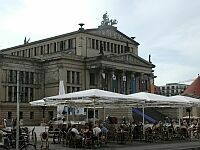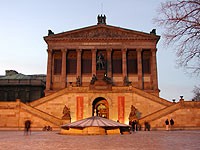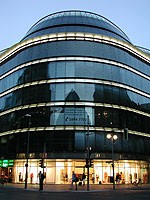|
|
|
Conference Venue
Berlin - Capital of Germany |
Berlin lies in the centre of Europe. Vienna,
Paris, Rome, Brussels, Prague and Moscow are all within quick reach
of the city which is the gateway between East and West. With about
3.4 million inhabitants, Berlin is the biggest city in Germany.
With its 38 kilometres long and 45 kilometres wide and an area of
889 square kilometres it is the largest city of Germany, too.
Its uniqueness stems from the merger of a beautiful environment,
culture, science, politics and commerce. | |
 |
| |
Berlin - Architecture |
Berlin has a great architectural tradition as well
as promising perspectives. Schinkel, Knobelsdorff, Schlüter and
Stüler are among the most famous master builders. The War and
the German Unification in 1990 gave way for a new wave of
architectural activities. Famous architects from around the world
such as Sir Norman Foster, Renzo Piano, Aldo Rossi, Daniel Libeskind
and many others have shown that modern architecture may become a
fascinating event. Catch this spirit and have a look at the
Reichstag Dome. | |
 |
| |
Berlin - Long History |
Berlin is slightly less than 800 years old. It
may be called young relative to other European cities. However,
it experienced so many highlights and disasters over the last
couple of centuries that hardly any other city can surpass Berlin.
Tolerance and terror as well as splendor and misery have influenced
the development of the city. Famous scientists like Planck,
Heisenberg or Einstein did their research here, Prussian Kings like
Frederick II and German Emperors ruled here and politicians like
Napoleon, Stalin, Truman, Kennedy and others stayed at Berlin -
what reasons so ever they had. | |

 |
| |
Berlin - Culture |
More than 170 museums await the visitor.
Archeological finds, modern and classical arts collections such
as Queen Nefertiti, the Pergamon Altar, Rembrandt, Picasso or the
contemporary avant-garde like Beuys or Warhol can be visited. They
provide what makes Berlin so very attractive. The Museum Island
in the city centre is a part of the world's cultural heritage.
Of course, Berlin's fine art of music is impressive. The Berlin
Philharmonic Orchestra as well the various operas should not be
missed. Principal conductors like Abbado, Barenboim, Nagano or Sir
Simon Rattle are world-wide known. If you prefer open air concerts
- Classic or Pop - make sure to visit the "Waldbühne". Living
at the frontier of East and West for more than four decades causes
stagnation or cultural dynamics. Berlin dedicated itself to
entertainment. Musical theatres, cabarets, or the
Friedrichstadtpalast fascinate as much as was the case in the
"Golden Twenties". | |
 |
| |
Berlin - Dining and Dancing |
Since ever Berlin is a merger of people coming
from nearly all directions. Since the wall came down and the
German Parliament marched in the level of gourmet cooking is
steadily increasing. Combine your own culinary tour within the
city. As Berlin does not have a "Polizeistunde" (closing hour)
you can later enter one of the many bars, clubs or ballrooms
of the "scene" at night and leave before noon of next day.
| |
 |
| |
Berlin - Shopping |
The visitor of Berlin should not go to London
in order to shop at Harrod's or Selfridge. It is fully sufficient
to stop at the KaDeWe - the largest department store of Europe
with thousand and thousand of articles in about 1500 shops.
But there is more like Lafayette, Friedrichstrasse or Arkaden,
Potsdamer Platz. As Berlin is a large city, it has many centers
ideal for shopping. This is what the visitor has to find out
himself. | |
 |
|
|

